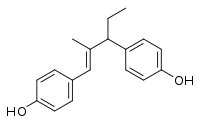Dianol
Dianol is a synthetic, nonsteroidal estrogen that was never marketed.[1] It is a dimer and impurity of anol, and was, along with hexestrol, involved in erroneous findings of highly potent estrogenic activity with anol.[2][3][4] Although a potent estrogen, it requires a dose of 100 μg to show activity, whereas hexestrol shows activity with a mere dose of 0.2 μg.[5]
 | |
| Identifiers | |
|---|---|
IUPAC name
| |
| Chemical and physical data | |
| Formula | C18H20O2 |
| Molar mass | 268.356 g·mol−1 |
| 3D model (JSmol) | |
SMILES
| |
InChI
| |
See also
- Anethole
- Dianethole
- Diethylstilbestrol
- Stilbestrol
References
- Dodds, E. C. (2008). "Synthetic œstrogens in treatment". The Irish Journal of Medical Science. 25 (7): 305–314. doi:10.1007/BF02950685. ISSN 0021-1265.
- Philipp Y. Maximov; Russell E. McDaniel; V. Craig Jordan (23 July 2013). Tamoxifen: Pioneering Medicine in Breast Cancer. Springer Science & Business Media. pp. 3–. ISBN 978-3-0348-0664-0.
- Vitamins and Hormones. Academic Press. 1 January 1945. pp. 232–. ISBN 978-0-08-086600-0.
- Enrique Ravina (11 January 2011). The Evolution of Drug Discovery: From Traditional Medicines to Modern Drugs. John Wiley & Sons. pp. 177–. ISBN 978-3-527-32669-3.
- SOLMSSEN UV (1945). "Synthetic estrogens and the relation between their structure and their activity". Chem. Rev. 37: 481–598. doi:10.1021/cr60118a004. PMID 21013428.
This article is issued from
Wikipedia.
The text is licensed under Creative
Commons - Attribution - Sharealike.
Additional terms may apply for the media files.